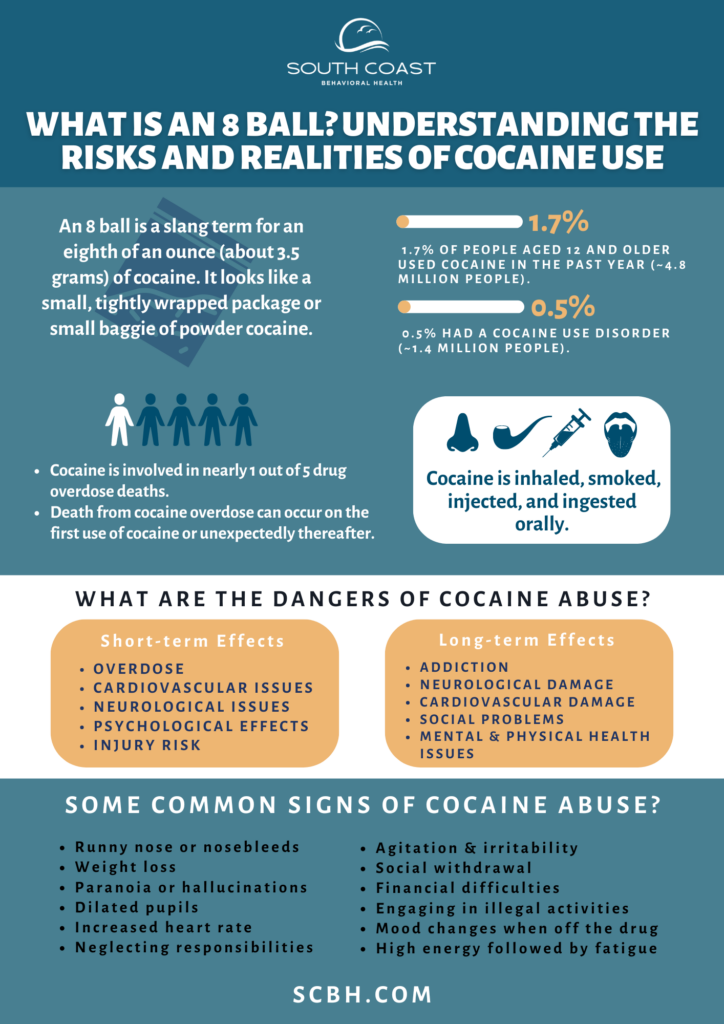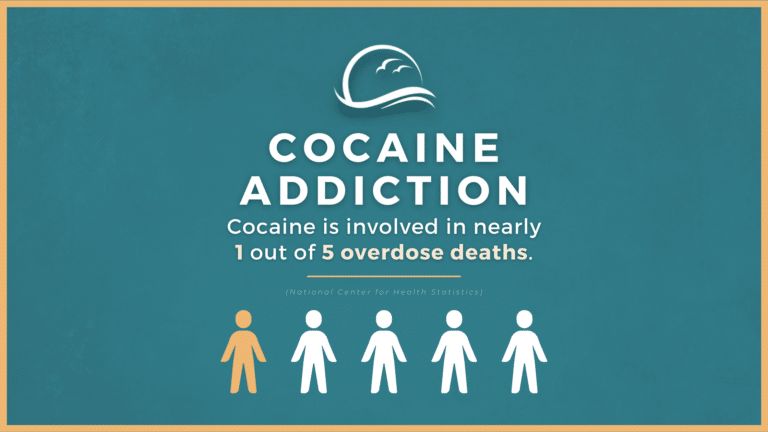What Is an 8 Ball Slang For?
Like dime bags, an 8 ball is a slang term for an amount of drugs: in this case, an eighth of an ounce (around 3.5 grams), usually of cocaine. It looks like a small, tightly wrapped package or small baggie of powder cocaine.
While it doesn’t sound like a lot, 3.5 grams (by comparison, a dime bag is roughly one gram) of cocaine is enough to cause a fatal overdose, especially if injected. As a result, It’s typically purchased by a group of people rather than one individual. Additionally, people tend to buy 8 balls collectively because it enables them to obtain more cocaine on a lower cost-per-user basis than buying the drug individually.
Here are some stats about cocaine use in the United States:
- In 2021, about 1.7% of people ages 12 and older reported using cocaine in the past 12 months – roughly 4.8 million people
- That same year, 0.5% (or around 1.4 million people) of adults aged 12 and older had a cocaine use disorder in the previous 12 months
- Cocaine is involved in nearly 1 out of 5 deaths due to drug overdose
Just to be clear, an 8 ball is different from crack cocaine. Crack is a form of cocaine that has been processed to create a rock crystal that can be smoked.
Cocaine is classified as a Schedule II drug under the Controlled Substances Act due to its high potential for abuse. If you or a loved one is habitually buying 8 balls of cocaine, it’s time to consider substance abuse treatment.

What Are the Signs of Cocaine Addiction?
One of the hallmarks of cocaine addiction, like all forms of drug addiction, is the continued use of the substance despite negative consequences. This means that even when the use of cocaine is causing problems in their life, an addicted individual will continue to use it.
With that being said, there are various signs someone may be addicted to cocaine.
Physical signs of cocaine addiction may include:
- Frequent runny nose or nosebleeds, which can be a result of snorting cocaine
- Weight loss due to suppressed appetite
- Dilated pupils
- Increased heart rate or blood pressure
- Insomnia or significant changes in sleep patterns
- High energy levels, followed by extreme fatigue
- Over time, more serious health problems can occur, such as heart disease, stroke, and severe mental health issues
Behavioral signs of cocaine addiction can include:
- Increased agitation, irritability, or restlessness.
- Paranoia or hallucinations.
- Changes in social habits or relationships – often, people using cocaine will withdraw from their regular activities and may lose interest in things they once enjoyed.
- Neglecting responsibilities – this could be at work, school, or home.
- Financial difficulties, possibly due to spending large amounts of money on the drug.
- Going to great lengths to obtain more cocaine, even if it means engaging in illegal activities.
- Cocaine withdrawal symptoms, such as changes in mood and behavior when the effects of the drug wear off. These might include depression, fatigue, and increased appetite.
- Being found with an 8 ball or dime bag
If you or someone you know is displaying signs of cocaine addiction, it’s crucial to seek help immediately. You have various options available to you, including rehabilitation centers, therapy, and support groups. Always remember that help is available and that recovery is possible.
What Are the Dangers of Cocaine Abuse?
An 8 ball of cocaine – or any kind of stimulant drug, for that matter – can be potent and highly addictive. The dangers can be categorized into short-term and long-term effects.
Short-term effects:
- Overdose — Taking an 8 ball can lead to overdose, which may be fatal. Signs of a cocaine overdose include severe anxiety, panic, very high blood pressure, very high heart rate, excessive sweating, hallucinations, and delirium.
- Cardiovascular problems — Cocaine significantly increases heart rate and blood pressure, which can cause chest pain, heart attacks, and even sudden death, even in people who are otherwise healthy.
- Neurological issues — An 8 ball of cocaine can cause seizures, stroke, and other neurological emergencies.
- Psychological effects like panic attacks, paranoia, psychosis, and other bizarre behavior
- Increased risk of injury or accident.
Long-term effects:
- Addiction
- Neurological damage
- Cardiovascular damage
- Mental health issues
- Physical health deterioration
- Social and personal problems
Remember, it’s important to seek help immediately if you or someone you know is struggling with cocaine abuse. There are many resources available that provide help for substance abuse and addiction.

How is Cocaine Addiction Diagnosed and Treated?
The diagnosis of cocaine addiction, also known as cocaine use disorder, is usually made by a mental health professional or physician using the criteria outlined in the Diagnostic and Statistical Manual of Mental Disorders (DSM-5). This is the handbook used by healthcare professionals as the authoritative guide to diagnosing mental disorders.
The DSM-5 criteria for cocaine use disorder is at least two of the following symptoms in a 12-month period:
- Using more cocaine or using it for a longer time than intended. Someone constantly buying 8 balls of cocaine would be an example of this.
- Persistent desire or unsuccessful efforts to cut down or control cocaine use.
- Spending a great deal of time obtaining, using, or recovering from the effects of cocaine.
- Craving, or a strong desire to use cocaine.
- Continued cocaine use despite having persistent or recurrent social or interpersonal problems caused or exacerbated by the effects of cocaine.
- Important social, occupational, or recreational activities given up or reduced because of cocaine use.
- Recurrent cocaine use in situations in which it is physically hazardous.
- Continued cocaine use despite knowledge of having a persistent or recurrent physical or psychological problem that is likely to have been caused or exacerbated by cocaine.
- Tolerance, as defined by either a need for markedly increased amounts of cocaine to achieve intoxication or desired effect, or a markedly diminished effect with continued use of the same amount of cocaine.
- Withdrawal, as manifested by either the characteristic withdrawal syndrome for cocaine or the use of cocaine (or a closely related substance) to relieve or avoid withdrawal symptoms.
These criteria provide a framework for diagnosis, but the process also often includes a complete medical history, a physical exam, and sometimes, lab tests to rule out other health problems.
Relapse is common with cocaine addiction, so long-term treatment and follow-up are essential for maintaining sobriety. If you or someone you know is struggling with cocaine addiction, it’s important to seek help from a healthcare provider.
Cocaine Addiction Treatment at South Coast Behavioral Health
If you or a loved one are abusing dime bags or 8 balls of cocaine, it’s time to seek professional help. South Coast Behavioral Health offers compassionate and affordable cocaine addiction treatment.
These levels of treatment are, in order, as follows:
- Detoxification
- Residential
- Partial hospitalization
- Intensive outpatient treatment
Treatment for substance abuse takes place along an entire spectrum of care. Along that entire spectrum are various behavioral therapies, support groups, and the use of medically-assisted treatment (MAT).
Medical Detox Program in California
The first step in treating a stimulant addiction is a medical detox. This means using drugs to manage withdrawal symptoms. Our medical detox program in California is staffed by caring and compassionate professionals who can provide you with medications to manage your withdrawal symptoms.
At South Coast, we take pride in offering care that is closely tailored to specific issues. To that end, we offer gender-specific detox programs, with medical detox for men in Irvine, CA, and medical detox for women in Huntington Beach, CA.
After detoxing, proper treatment can begin.
Residential Treatment in California
After successfully completing medical detox, you’ll receive inpatient treatment in Orange County California. There, you’ll receive medically-assisted treatment and dual diagnosis treatment to deal with any cravings or co-occurring mental health issues you may be battling. We also offer residential treatment facilities in Costa Mesa, Irvine, and Huntington Beach for those who desire gender-specific treatment. There, clients get round-the-clock medical attention and monitoring while living at the institution full-time. In addition to individual and group counseling and medication management, you’ll also have access to leisure activities and family support services.
Partial Hospitalization in California
Most clients start substance abuse treatment with South Coast in our residential treatment program. After completing that, many desire something that still provides structure and support, but with extra space and time to oneself. For that, we offer Partial Hospitalization in Newport Beach.
A step down from inpatient care but with more structure than conventional outpatient programs, partial hospitalization offers a good balance for those looking to ease back into normal life. Clients can receive care five to seven days a week for a number of hours each day, returning back to their homes in the evening.
This way, they can recover without putting their daily lives completely on hold, receiving intense therapeutic interventions like group and individual therapy, skill development, and medication management as necessary.
Intensive Outpatient Treatment in California
For those leaving inpatient residential treatment or partial hospitalization, intensive outpatient programs (IOP) are yet another gradual step forward on the road to recovery.
With a focus on group therapy, individual counseling, and education, clients undergoing Intensive Outpatient Treatment in Newport Beach can meet three to five days a week. Each session lasts three hours. This level of care requires the least amount of attendance at a facility.
Help For Cocaine Addiction
If you or a loved one are struggling with cocaine addiction but wonder how long addiction treatment takes or have other questions, call us at 866-881-1184 or contact us here. Our highly qualified staff will be happy to help give you an idea on what to expect from your addiction recovery timeline, help verify your insurance, and assist with any other questions you may have.









